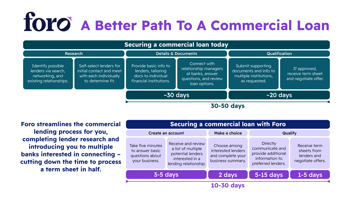How To Value Your Business | Foro

Whether you’re planning to sell your company, explore financing options or simply chart its progress, it’s essential to know its true value. These ideas could help you attach an accurate, useful dollar figure to your business.
-----
What is your business really worth?
That’s a crucial question if you’re considering a sale of your company, and it can also be important if you’re seeking financing from a bank or an investor, says Will Howard, head of Relationship Management at Foro. But the answer is also helpful as a way to track your business’s progress, Howard says. “If you’re scrambling to understand the value of your business in a certain three- to six-month period—say, just before a potential sale—you may come up with a figure,” he says. “But that number is likely to be vastly different, and much less useful, than if you had been tracking the value for the past five years.”
Fortunately, coming up with at least a rough calculation of the value of your company needn’t be difficult, Howard says. Here’s his advice about the dos and don’ts of business valuation.
Choose the right tools
Larger businesses often require complex enterprise valuation models, Howard says. Depending on your industry, if you have more than $25 million to $50 million in annual sales, you may need a discounted cash flow analysis (DCF), a method that seeks to establish a fair market value for a business based on expected future cash flows. Historical data about the company as well as forecasted sales growth, profit margins, cost of capital and potential risks may be part of this analysis. “DCF is just one of the complex enterprise valuation models that banks may use,” Howard says. “But all of those pull information on market capitalization and other metrics from public equity markets, looking at other companies in similar industries. Most smaller businesses shouldn’t try to compare themselves to public companies in that way.” For those businesses, DCF and similar models are likely to provide a highly subjective valuation that may not be accurate, he says.
Consider the basics
If your company’s revenue falls below that $25 million to $50 million threshold, you can take a simpler approach to company valuation, Howard says. “You already have the tools to make a rough valuation,” he says. Consider your top-line revenue, your EBITDA (earnings before interest, taxes, depreciation, and amoritzation) and your profit margin, suggests Howard. Valuation is often expressed as a multiple of EBITDA. Larger and more established companies, in terms of their revenue ranges, tend to sell for higher multiples than smaller companies. In addition, within the range of multiples for similar businesses—say, from two to four times EBITDA—those with higher margins are likely to be near the top of the range.
Look inward, not outward
It’s natural to compare your business with others that may be in the same industry or have a similar profile. But without digging deep into another company’s financials, you can’t really know how well the two measure up. It’s much more effective, says Howard, to delve into your own company’s performance and overall health and trajectory. “No one else knows your business as well as you do,” he says.
Have an honest conversation with yourself
“You need to be realistic about what someone is going to pay you for your business’s cash flow,” Howard says. “Because unless you have real estate or other significant hard assets, it’s cash flow—and especially future cash flow—that they’re buying.” Yet business owners, who have invested their blood, sweat and tears into building the company, are very likely to overestimate what the company and its cash flow will actually be worth to someone else. “It’s important to realize that no one else is going to appreciate it as much as you do,” Howard says. “So be conservative. Business owners who value their businesses conservatively are my favorite people to work with. There’s nothing better than helping someone realize a company is actually worth more than they thought it was.”
Be prepared when you talk with capital providers
All of the things Howard has discussed here should be considered prerequisites for having a substantive conversation with a lender or a potential investor. Getting a handle on your revenue and cash flow and how that has changed for your company over time can lead to an intelligent, productive discussion of your capital needs, says Howard, who notes that “turns of leverage’ is a phrase that’s likely to come up. “A turn of leverage is simply a number times your EBITDA,” he says. Three turns of leverage is three times your EBITDA, for example—and three turns of leverage is the maximum for most traditional bank loans, Howard says.
Defend your valuation
If you have done your homework and have good reasons for your valuation of the business, don’t be afraid to challenge a bank’s lower numbers, Howard says. “If someone says your valuation is way off, ask how they came up with their valuation, and then walk them through how you came to yours,” he says. “When a business owner can defend a valuation, everyone will be taken aback—and they may well go along with your analysis.”
Cast a wide net for the support you need
Having at least a rough idea of what your business is worth can help you prepare for conversations with lenders. But in today’s challenging economic climate, many local banks may be unwilling or unable to provide financing. That’s where Foro’s proprietary technology could help. After a business owner fills out a single online form—answering questions about the amount and purpose of the funding, the size of the company, its industry and other information—the technology uses artificial intelligence to match the business with lenders that are most likely to be interested in supporting a business such as yours. “Some business owners come to us and say they’ve never raised capital before and don’t know how to do it,” Howard says. “We can help them find the right lender in the right place with the right appetite.”
Get knowledgeable advice and guidance
The financing needs of some businesses are more complex, however, and even a lender that’s a perfect match may not be willing to provide all of the capital those companies seek, regardless of their valuation. Howard tells of one business that needed to secure $10 million in financing. Banks were willing to lend $8 million but wanted the business to come up with the other $2 million in new equity. In this case, the business owner worked with Foro Capital Markets, an advisory service that can help businesses meet specialized needs. In a situation like this, a team of Foro experts, with deep experience in creating complex capital structures, could help raise that additional equity, or it might secure $2 million in junior debt. “Either way, the company doesn’t have to compromise on the amount of the financing and can get the full $10 million in one smooth simultaneous process,” he says.
Revisit your business valuation often
Knowing what your business is worth can be crucial if you’re considering a sale or raising capital, Howard says. But he reiterates that it also makes sense to do a business valuation as a recurring exercise. “Look at your current cash flow and your revenue and margins and see where they’re projected to go,” he says. Doing that quarterly, twice a year or even annually can give you a sense of your business’s progress, and help you prepare for what’s ahead.
Please visit Foro.io for more ideas on finding capital, for information on types of loans available to businesses like yours and to learn how a powerful search platform could help transform your business.
About The Author: David Bumke
A career magazine editor, who led Runner’s World, Individual Investor, and other national titles, as well as a veteran business and financial writer, David Bumke creates award-winning print and online content for a wide range of corporate and nonprofit clients. He was a founding editor of Proto, published by Massachusetts General Hospital, which for 17 years explored the global frontiers of medicine and public health.
-Jan-03-2024-02-44-48-9464-PM.png?width=1000&height=187&name=Blog%20CTA_1000%20%C3%97%20187%20px%20(7)-Jan-03-2024-02-44-48-9464-PM.png)


